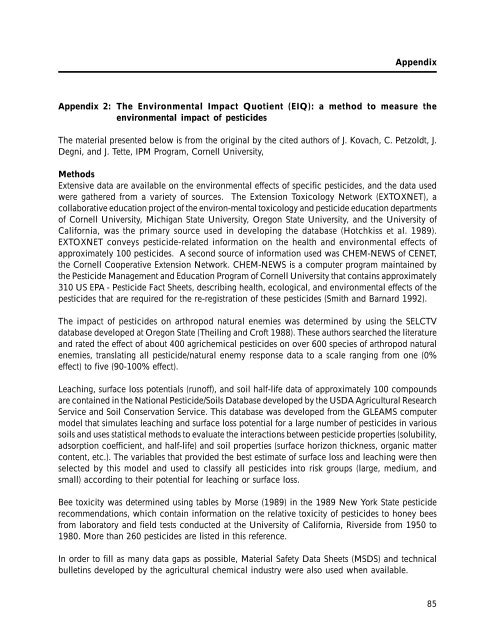GM Crops: The First Ten Years - International Service for the ...
GM Crops: The First Ten Years - International Service for the ...
GM Crops: The First Ten Years - International Service for the ...
Create successful ePaper yourself
Turn your PDF publications into a flip-book with our unique Google optimized e-Paper software.
Appendix<br />
Appendix 2: <strong>The</strong> Environmental Impact Quotient (EIQ): a method to measure <strong>the</strong><br />
environmental impact of pesticides<br />
<strong>The</strong> material presented below is from <strong>the</strong> original by <strong>the</strong> cited authors of J. Kovach, C. Petzoldt, J.<br />
Degni, and J. Tette, IPM Program, Cornell University,<br />
Methods<br />
Extensive data are available on <strong>the</strong> environmental effects of specific pesticides, and <strong>the</strong> data used<br />
were ga<strong>the</strong>red from a variety of sources. <strong>The</strong> Extension Toxicology Network (EXTOXNET), a<br />
collaborative education project of <strong>the</strong> environ-mental toxicology and pesticide education departments<br />
of Cornell University, Michigan State University, Oregon State University, and <strong>the</strong> University of<br />
Cali<strong>for</strong>nia, was <strong>the</strong> primary source used in developing <strong>the</strong> database (Hotchkiss et al. 1989).<br />
EXTOXNET conveys pesticide-related in<strong>for</strong>mation on <strong>the</strong> health and environmental effects of<br />
approximately 100 pesticides. A second source of in<strong>for</strong>mation used was CHEM-NEWS of CENET,<br />
<strong>the</strong> Cornell Cooperative Extension Network. CHEM-NEWS is a computer program maintained by<br />
<strong>the</strong> Pesticide Management and Education Program of Cornell University that contains approximately<br />
310 US EPA - Pesticide Fact Sheets, describing health, ecological, and environmental effects of <strong>the</strong><br />
pesticides that are required <strong>for</strong> <strong>the</strong> re-registration of <strong>the</strong>se pesticides (Smith and Barnard 1992).<br />
<strong>The</strong> impact of pesticides on arthropod natural enemies was determined by using <strong>the</strong> SELCTV<br />
database developed at Oregon State (<strong>The</strong>iling and Croft 1988). <strong>The</strong>se authors searched <strong>the</strong> literature<br />
and rated <strong>the</strong> effect of about 400 agrichemical pesticides on over 600 species of arthropod natural<br />
enemies, translating all pesticide/natural enemy response data to a scale ranging from one (0%<br />
effect) to five (90-100% effect).<br />
Leaching, surface loss potentials (runoff), and soil half-life data of approximately 100 compounds<br />
are contained in <strong>the</strong> National Pesticide/Soils Database developed by <strong>the</strong> USDA Agricultural Research<br />
<strong>Service</strong> and Soil Conservation <strong>Service</strong>. This database was developed from <strong>the</strong> GLEAMS computer<br />
model that simulates leaching and surface loss potential <strong>for</strong> a large number of pesticides in various<br />
soils and uses statistical methods to evaluate <strong>the</strong> interactions between pesticide properties (solubility,<br />
adsorption coefficient, and half-life) and soil properties (surface horizon thickness, organic matter<br />
content, etc.). <strong>The</strong> variables that provided <strong>the</strong> best estimate of surface loss and leaching were <strong>the</strong>n<br />
selected by this model and used to classify all pesticides into risk groups (large, medium, and<br />
small) according to <strong>the</strong>ir potential <strong>for</strong> leaching or surface loss.<br />
Bee toxicity was determined using tables by Morse (1989) in <strong>the</strong> 1989 New York State pesticide<br />
recommendations, which contain in<strong>for</strong>mation on <strong>the</strong> relative toxicity of pesticides to honey bees<br />
from laboratory and field tests conducted at <strong>the</strong> University of Cali<strong>for</strong>nia, Riverside from 1950 to<br />
1980. More than 260 pesticides are listed in this reference.<br />
In order to fill as many data gaps as possible, Material Safety Data Sheets (MSDS) and technical<br />
bulletins developed by <strong>the</strong> agricultural chemical industry were also used when available.<br />
85
















